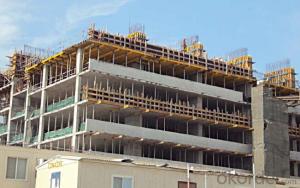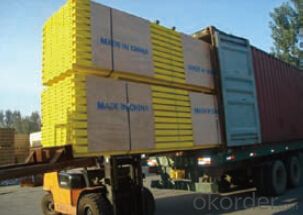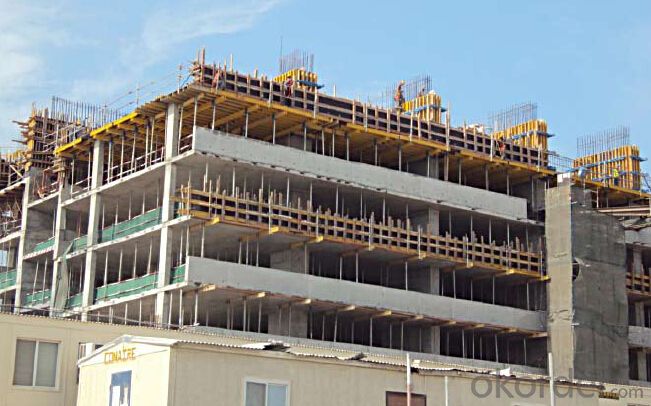Timber-Beam Formwork H20 for formwork and scaffolding system
- Loading Port:
- Tianjin
- Payment Terms:
- TT OR LC
- Min Order Qty:
- 50 m²
- Supply Capability:
- 1000 m²/month
OKorder Service Pledge
OKorder Financial Service
You Might Also Like
Characteristics:
◆ Standardized production lines.
Supply capability: 3000m/day, Lmax = 6600mm.
◆ Finger jointing of the flange and web, the strength of timber beam is highly improved.
Max. shearing force failure load:40KN
◆ Well treated to prevent from water penetration or erosion, so the service life maximally
extended.
Normally, CNBM timber beam H20 can be used for 4 to 5 years, the exact using time would
depend on maintenance & storage.
◆ Robust caps at the end of the girders protect against damages.
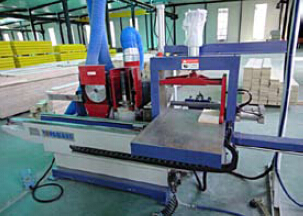
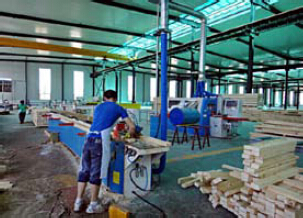

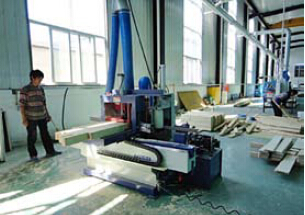
- Q: Can steel formwork be used for elevated walkways?
- Yes, steel formwork can be used for elevated walkways. Steel formwork is a versatile and durable construction material that can be used for various applications, including the construction of elevated walkways. Steel formwork systems are known for their strength and stability, making them ideal for supporting the weight and load of a walkway. The use of steel formwork for elevated walkways ensures a safe and robust structure that can withstand heavy foot traffic and adverse weather conditions. Additionally, steel formwork offers flexibility in design, allowing for the creation of customized walkways with different shapes and sizes. Overall, steel formwork is a suitable choice for constructing elevated walkways due to its strength, durability, and versatility.
- Q: What are the common design considerations for steel formwork in bridge construction?
- When discussing steel formwork in bridge construction, there are several important factors that must be taken into consideration. These factors include: 1. Ensuring Strength and Stability: Engineers must design the steel formwork to withstand the various loads it will encounter during construction, including the weight of wet concrete and any equipment used. The formwork needs to provide sufficient strength and stability to ensure the safety of workers and the integrity of the structure. 2. Emphasizing Durability and Reusability: Designing the steel formwork to be durable and reusable is essential. It should be able to endure multiple uses without significant deterioration, which helps reduce costs and minimize waste. 3. Allowing for Flexibility and Adaptability: The design of the steel formwork should be flexible and adaptable to accommodate different bridge geometries and dimensions. This is particularly important as each bridge may have unique design requirements. 4. Prioritizing Ease of Assembly and Disassembly: The formwork should be designed for easy assembly and disassembly, as this expedites the construction process and reduces labor costs. Quick and efficient assembly and disassembly can also minimize disruptions to traffic flow during construction. 5. Focusing on Safety: Safety is a critical consideration in any construction project, including steel formwork. The design should incorporate safety features to protect workers during assembly, disassembly, and concrete pouring. These features may include guardrails, access platforms, and fall protection systems. 6. Striving for Cost-effectiveness: The design of the steel formwork should aim to be cost-effective. This involves considering factors such as material selection, fabrication methods, and ease of transport and installation. The goal is to optimize the overall cost of the formwork while maintaining its functionality and performance. In conclusion, the design considerations for steel formwork in bridge construction revolve around ensuring strength, stability, durability, reusability, flexibility, adaptability, ease of assembly and disassembly, safety, and cost-effectiveness. By carefully addressing these considerations, engineers can ensure the successful and efficient construction of bridges using steel formwork.
- Q: How does steel formwork handle different concrete surface coloring techniques?
- Steel formwork is a versatile and durable material that effectively handles various concrete surface coloring techniques. The main advantage of using steel formwork lies in its smooth and non-porous surface, which guarantees even application of concrete coloring techniques and desired results. When it comes to concrete surface coloring techniques like staining, stamping, or integral coloring, steel formwork offers a stable and consistent foundation for these processes. The seamless surface of steel formwork allows for uniform and attractive distribution of colorants or pigments, ensuring a cohesive appearance of the final concrete surface. Moreover, the strength and rigidity of steel formwork make it suitable for different concrete surface coloring techniques. Whether it involves stamping, which necessitates the pressing of textured patterns onto the concrete surface, or staining, which requires precise application of colorants, steel formwork provides the necessary support and stability to execute these techniques accurately. Furthermore, the durability of steel formwork renders it resistant to damage during the coloring process. Concrete surface coloring techniques often involve the use of chemicals, dyes, or stains that can potentially harm weaker or less resistant formwork materials. However, the robustness of steel formwork allows it to withstand the harsh chemicals and coloring agents without compromising its structural integrity. In conclusion, steel formwork is an excellent choice for handling diverse concrete surface coloring techniques. Its smooth and non-porous surface ensures the even distribution of colorants, while its strength and rigidity provide the necessary support for techniques such as stamping or staining. Additionally, the durability of steel formwork protects it from damage caused by chemicals or coloring agents, ensuring a successful and visually pleasing outcome.
- Q: What are the different types of steel formwork available?
- There are several types of steel formwork available, including traditional steel formwork, modular steel formwork, and tunnel formwork. Traditional steel formwork consists of steel panels that are assembled on-site and can be used repeatedly. Modular steel formwork is prefabricated and can be easily assembled and disassembled, making it more efficient and cost-effective. Tunnel formwork is specifically designed for the construction of tunnel structures and is made of steel plates that are interconnected to form a continuous wall.
- Q: How does steel formwork handle different concrete surface cleaning methods?
- Steel formwork is a durable and versatile option for concrete construction projects. When it comes to cleaning the concrete surface, steel formwork can handle various methods effectively. One common method of cleaning concrete surfaces is pressure washing. Steel formwork can withstand high-pressure water jets without any damage. The smooth and non-porous surface of steel formwork makes it easy to remove dirt, debris, and any other unwanted materials from the concrete surface. Pressure washing can effectively clean the surface, ensuring a smooth and even finish. Another method used for concrete surface cleaning is chemical cleaning. Steel formwork is resistant to most chemicals commonly used for cleaning purposes. This allows for the use of various cleaning agents to remove stubborn stains, oil, grease, and other contaminants from the concrete surface. The chemical cleaning process can be performed without causing any harm or degradation to the steel formwork. In some cases, manual cleaning methods may also be employed. Steel formwork can handle manual scrubbing, brushing, or scraping without any issues. The strength and durability of steel make it suitable for manual cleaning methods, which may be necessary for removing tough stains or debris that cannot be easily removed through other means. Overall, steel formwork is an ideal choice for handling different concrete surface cleaning methods. Its resistance to pressure washing, chemical cleaning, and manual cleaning methods ensures that the concrete surface can be effectively cleaned without causing any damage to the formwork. This allows for a clean and aesthetically pleasing finish, while also maintaining the structural integrity of the formwork.
- Q: What are the common types of steel used for formwork?
- The common types of steel used for formwork can vary depending on the specific application and requirements. However, there are a few types of steel that are commonly used in formwork construction. 1. Mild Steel: This is the most commonly used type of steel for formwork. It is affordable, readily available, and easy to work with. Mild steel has a low carbon content, making it relatively soft and easy to bend or shape. However, it may not be suitable for heavy-duty or high-stress applications. 2. High Tensile Steel: High tensile steel, also known as high-strength steel, is a stronger and more durable option compared to mild steel. It contains alloys that increase its tensile strength, making it ideal for use in heavy-duty formwork applications where higher loads or stresses are expected. High tensile steel is more expensive than mild steel but offers enhanced structural integrity. 3. Stainless Steel: Stainless steel is often used in formwork applications where corrosion resistance is crucial. It contains a high percentage of chromium, which forms a protective layer on the surface, preventing rust and corrosion. Stainless steel is commonly used in marine or coastal construction projects, as well as in areas with high humidity or chemical exposure. 4. Reinforcing Steel: Reinforcing steel, also known as rebar, is commonly used in reinforced concrete formwork. It consists of steel bars or mesh that are embedded within the concrete to provide additional strength and stability. Reinforcing steel is typically made of carbon steel, but stainless steel rebar is also available for applications that require corrosion resistance. It is important to consider factors such as the load requirements, environmental conditions, and budget constraints when selecting the appropriate type of steel for formwork. Consulting with a structural engineer or construction professional can help ensure the right steel type is chosen for the specific project.
- Q: Can steel formwork be used for both single-storey and multi-storey buildings?
- Yes, steel formwork can be used for both single-storey and multi-storey buildings. Steel formwork is versatile and can be easily adjusted and customized to fit different building sizes and shapes. It offers excellent strength, durability, and stability, making it suitable for constructing single-storey structures as well as multi-storey buildings. Steel formwork allows for faster construction and provides a smooth and high-quality finish to concrete structures. Additionally, steel formwork can be reused multiple times, making it cost-effective and sustainable for both single-storey and multi-storey construction projects.
- Q: Can steel formwork be used for shopping mall construction projects?
- Yes, steel formwork can be used for shopping mall construction projects. Steel formwork is a popular choice for construction projects due to its durability, strength, and versatility. It provides a strong and rigid structure that can withstand the pressures of a shopping mall construction project. Additionally, steel formwork allows for easy customization and modification, which is beneficial when constructing complex structures like shopping malls. Moreover, steel formwork offers a smooth and high-quality finish, ensuring that the final result meets the aesthetic requirements of a shopping mall. Overall, steel formwork is a suitable option for shopping mall construction projects due to its strength, durability, versatility, and aesthetic appeal.
- Q: What are the considerations when designing steel formwork for architectural canopies?
- When it comes to designing steel formwork for architectural canopies, there are several important factors to consider. These factors are as follows: 1. Structural Integrity: It is crucial to design the formwork in a way that can withstand the various loads imposed on the canopy, including dead loads, live loads, and potential additional loads such as hanging fixtures. The aim is to make the steel formwork sturdy enough to ensure the stability and safety of the canopy. 2. Aesthetic Appeal: Architectural canopies are often created to enhance the overall visual appeal of a building. Therefore, the steel formwork should be designed in a manner that complements the desired aesthetics of the canopy. This can involve incorporating decorative elements, like patterns or textures, into the formwork design. 3. Ease of Installation: The formwork should be designed to be easily and efficiently installed. This can be achieved by using modular components that can be quickly and easily assembled on-site. It is also important to consider the weight and size of the formwork elements to ensure safe handling and installation. 4. Durability and Maintenance: The steel formwork must be designed to withstand the environmental conditions it will be exposed to. This may involve incorporating protection against corrosion, UV radiation, and other factors that can cause deterioration. Additionally, the formwork should be designed for easy maintenance and repair if necessary. 5. Functionality: The formwork needs to be designed to accommodate any specific functional requirements of the canopy. This can include providing space for utility connections, like lighting or drainage systems, or incorporating features such as rainwater collection systems. 6. Cost-effectiveness: The design of the steel formwork should take into account the overall cost of the canopy project. This includes not only the initial cost of the formwork but also factors such as ease of transportation and installation, as well as long-term maintenance costs. In conclusion, creating steel formwork for architectural canopies requires a careful balance between structural integrity, aesthetics, functionality, and cost-effectiveness. By considering these factors, architects and engineers can ensure the successful implementation of visually appealing and structurally sound canopies.
- Q: Can steel formwork be customized to meet specific project requirements?
- Yes, steel formwork can be customized to meet specific project requirements. Steel formwork is highly versatile and can be easily modified and fabricated to fit any shape or size needed for a particular project. This adaptability allows for greater flexibility in construction, ensuring that the formwork meets the precise specifications and dimensions required for the project.
Send your message to us
Timber-Beam Formwork H20 for formwork and scaffolding system
- Loading Port:
- Tianjin
- Payment Terms:
- TT OR LC
- Min Order Qty:
- 50 m²
- Supply Capability:
- 1000 m²/month
OKorder Service Pledge
OKorder Financial Service
Similar products
Hot products
Hot Searches
Related keywords

